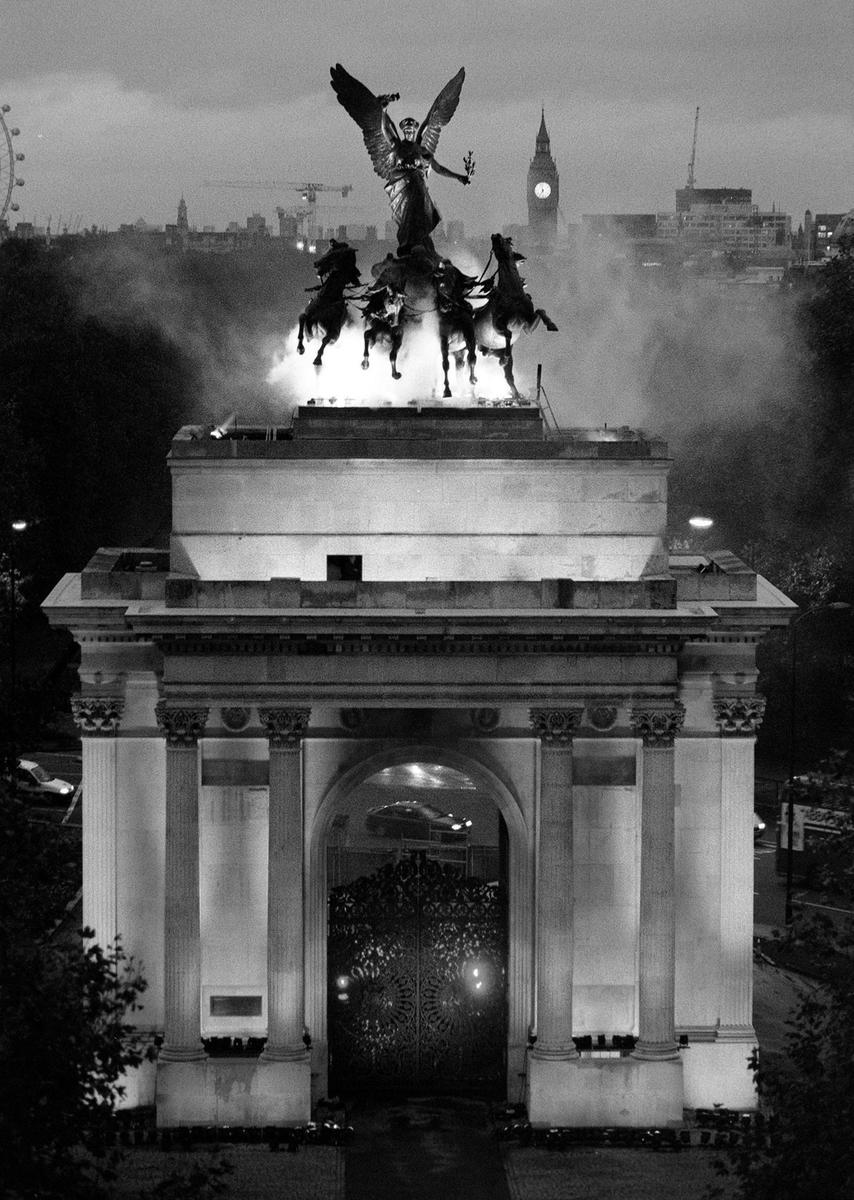
I would like to say I have been moved by some war memorials in Central London but can only say for certain that I have moved by them. By way of the No 8 bus, which goes from Victoria Station to the East End, I have gone whirling past a collection of statues at Hyde Park Corner. I sit on the top deck, with tourists and hoodies and Somalis and Poles. The sharp turn of the bus lurching through a roundabout approximates a swoon.
With neck craned, I see the ferocious snarl of horses reacting to the demands of an invisible master; a serene woman presides over the chariot. In one hand she holds aloft a wreath. Speed does not allow an easy translation of her attributes. Is she Britannia? Some Anglo-Valkyrie? Later I learn that this is a quadriga, sister to those that guard the Brandenburg Gate and Arc de Triomphe, and the woman is identified, alternately, as Victory, Fama, or Peace. The four horses writhe under her command, their manes flick into terrible shapes, snorts cracking through bronze hides.
The quadriga, or Peace Descending on the Chariot of War, stands not at ground level, nor even atop a modest base. She is perched at the peak of the Wellington Arch. She is descending on us. It all happens so quickly, the bus going round, Peace galloping not through but down from this gateway built to celebrate the English victor of Waterloo. Peace and her four horses began their descent in 1912, replacing a statue of Wellington that had been removed to Aldershot, a London suburb that is also a major military base.
But Peace came at a bad time. War made it there first. In front of the Wellington Arch, more or less directly in the quadriga’s path, is the monument to those men of the Royal Regiment of Artillery lost in World War I. There are four of them, too, guarding the crypt at each of the points of the compass. But from the bus I do not know this. It is just the monument with the dead soldier and the winged soldier. On one side of the sepulchral plinth is a soldier who has fallen in battle. He falls just as the bus rounds the bend: the stone is his cooling board, his greatcoat is a shroud drawn over his face and torso, the helmet on his chest is equipment for the underworld. The winged soldier wears a cape and leans against the wall with outstretched arms; the cape makes him appear as though he is about to take flight. But where Peace and her horses seem engaged in a race, this soldier is entirely without momentum. His wings are cruciform, he is braced against the wall, his chin droops down to his chest.
After noticing these soldiers from the bus, I later went back to see the other two figures. The third in the group stands stolid as a sentinel, feet planted firm. The fourth is shown reading letters from home. Together these men are meant to represent the realities of war. Wrapped around the sides of the base are the names of the places where the men of the Royal Artillery fought and fell: Mesopotamia. Arabia. India. Russia. Palestine. Central Asia. Persia. Africa. Dardanelles. Macedonia.
These place names tell us very little. They cannot pull the drapes from the faces of the dead. The names of certain battlefields tell their own story, of course, like Waterloo (the word itself an agreement between ourselves and history, a destiny conveyed by the name of a marshy plain). But I passed these monuments in ignorance, and I did not come away with a particular tribute to a particular heroism. From the bus window I thought the soldiers and the lady on the chariot were part of the same monument, time collapsed by the memory of all wars.
Indeed, here is victory, here is death. They cancel each other out at the very moment each makes the other possible. Victory’s triumph is the triumph of death. It seems only fitting that the angel of the quadriga is known by three monikers — Peace, Victory, Fame — all aliases to conceal her true name.
My first reaction to this was predictable. We feel we should protest. Something about the grossness of the display. Something about the extravagances of the state. Something about the indignity of death. All half-formed and general, in order to escape the fully-formed and specific and somehow unacceptable feeling that persists while staring out the window rounding Hyde Park Corner, while copying down names of brigades on pillars at the entrance to the Euston railway, reading the names of railway workers engraved high on a marble wall at Liverpool Street Station next to the McDonald’s. To the Glory of God and In Sacred Memory of… we want to revile this prostration, condemn it, blast it open with dynamite.
This sense of repulsion is reactionary, because we actually want to be a part of it, to know it, to undo the mystery sealed in the stone. At the foot of a monument, we are asked to remember something we do not, cannot, know. The operation is vague but compelling and in this resembles that most vague and compelling of experiences: one’s own death. By this we are yoked to the cause. A brand of pity and sorrow arises. It is pity for ourselves: for having been born at all and for not remembering it; for being creatures who will die and not remember that.